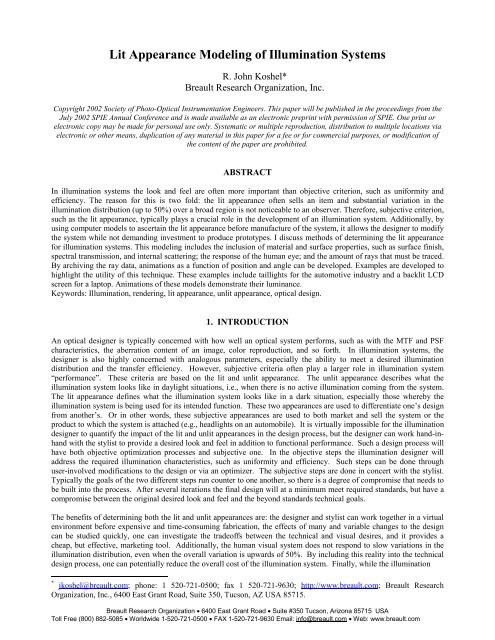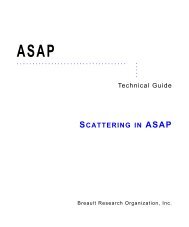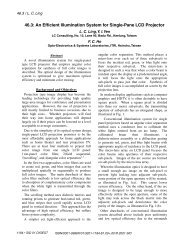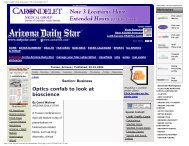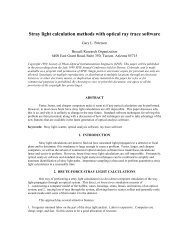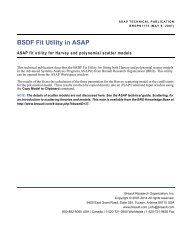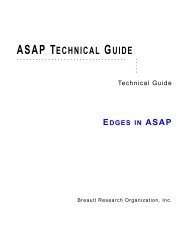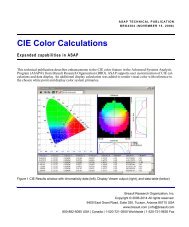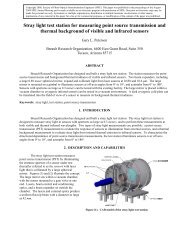Lit Appearance Modeling of Illumination Systems - Breault Research ...
Lit Appearance Modeling of Illumination Systems - Breault Research ...
Lit Appearance Modeling of Illumination Systems - Breault Research ...
You also want an ePaper? Increase the reach of your titles
YUMPU automatically turns print PDFs into web optimized ePapers that Google loves.
<strong>Lit</strong> <strong>Appearance</strong> <strong>Modeling</strong> <strong>of</strong> <strong>Illumination</strong> <strong>Systems</strong><br />
R. John Koshel*<br />
<strong>Breault</strong> <strong>Research</strong> Organization, Inc.<br />
Copyright 2002 Society <strong>of</strong> Photo-Optical Instrumentation Engineers. This paper will be published in the proceedings from the<br />
July 2002 SPIE Annual Conference and is made available as an electronic preprint with permission <strong>of</strong> SPIE. One print or<br />
electronic copy may be made for personal use only. Systematic or multiple reproduction, distribution to multiple locations via<br />
electronic or other means, duplication <strong>of</strong> any material in this paper for a fee or for commercial purposes, or modification <strong>of</strong><br />
the content <strong>of</strong> the paper are prohibited.<br />
ABSTRACT<br />
In illumination systems the look and feel are <strong>of</strong>ten more important than objective criterion, such as uniformity and<br />
efficiency. The reason for this is two fold: the lit appearance <strong>of</strong>ten sells an item and substantial variation in the<br />
illumination distribution (up to 50%) over a broad region is not noticeable to an observer. Therefore, subjective criterion,<br />
such as the lit appearance, typically plays a crucial role in the development <strong>of</strong> an illumination system. Additionally, by<br />
using computer models to ascertain the lit appearance before manufacture <strong>of</strong> the system, it allows the designer to modify<br />
the system while not demanding investment to produce prototypes. I discuss methods <strong>of</strong> determining the lit appearance<br />
for illumination systems. This modeling includes the inclusion <strong>of</strong> material and surface properties, such as surface finish,<br />
spectral transmission, and internal scattering; the response <strong>of</strong> the human eye; and the amount <strong>of</strong> rays that must be traced.<br />
By archiving the ray data, animations as a function <strong>of</strong> position and angle can be developed. Examples are developed to<br />
highlight the utility <strong>of</strong> this technique. These examples include taillights for the automotive industry and a backlit LCD<br />
screen for a laptop. Animations <strong>of</strong> these models demonstrate their luminance.<br />
Keywords: <strong>Illumination</strong>, rendering, lit appearance, unlit appearance, optical design.<br />
1. INTRODUCTION<br />
An optical designer is typically concerned with how well an optical system performs, such as with the MTF and PSF<br />
characteristics, the aberration content <strong>of</strong> an image, color reproduction, and so forth. In illumination systems, the<br />
designer is also highly concerned with analogous parameters, especially the ability to meet a desired illumination<br />
distribution and the transfer efficiency. However, subjective criteria <strong>of</strong>ten play a larger role in illumination system<br />
“performance”. These criteria are based on the lit and unlit appearance. The unlit appearance describes what the<br />
illumination system looks like in daylight situations, i.e., when there is no active illumination coming from the system.<br />
The lit appearance defines what the illumination system looks like in a dark situation, especially those whereby the<br />
illumination system is being used for its intended function. These two appearances are used to differentiate one’s design<br />
from another’s. Or in other words, these subjective appearances are used to both market and sell the system or the<br />
product to which the system is attached (e.g., headlights on an automobile). It is virtually impossible for the illumination<br />
designer to quantify the impact <strong>of</strong> the lit and unlit appearances in the design process, but the designer can work hand-inhand<br />
with the stylist to provide a desired look and feel in addition to functional performance. Such a design process will<br />
have both objective optimization processes and subjective one. In the objective steps the illumination designer will<br />
address the required illumination characteristics, such as uniformity and efficiency. Such steps can be done through<br />
user-involved modifications to the design or via an optimizer. The subjective steps are done in concert with the stylist.<br />
Typically the goals <strong>of</strong> the two different steps run counter to one another, so there is a degree <strong>of</strong> compromise that needs to<br />
be built into the process. After several iterations the final design will at a minimum meet required standards, but have a<br />
compromise between the original desired look and feel and the beyond standards technical goals.<br />
The benefits <strong>of</strong> determining both the lit and unlit appearances are: the designer and stylist can work together in a virtual<br />
environment before expensive and time-consuming fabrication, the effects <strong>of</strong> many and variable changes to the design<br />
can be studied quickly, one can investigate the trade<strong>of</strong>fs between the technical and visual desires, and it provides a<br />
cheap, but effective, marketing tool. Additionally, the human visual system does not respond to slow variations in the<br />
illumination distribution, even when the overall variation is upwards <strong>of</strong> 50%. By including this reality into the technical<br />
design process, one can potentially reduce the overall cost <strong>of</strong> the illumination system. Finally, while the illumination<br />
* jkoshel@breault.com; phone: 1 520-721-0500; fax 1 520-721-9630; http://www.breault.com; <strong>Breault</strong> <strong>Research</strong><br />
Organization, Inc., 6400 East Grant Road, Suite 350, Tucson, AZ USA 85715.<br />
<strong>Breault</strong> <strong>Research</strong> Organization • 6400 East Grant Road • Suite #350 Tucson, Arizona 85715 USA<br />
Toll Free (800) 882-5085 • Worldwide 1-520-721-0500 • FAX 1-520-721-9630 Email: info@breault.com • Web: www.breault.com
system must meet the minimum standards requirements and the like, it is the appearance <strong>of</strong> the product that sells it. The<br />
illumination designer must always remain cognizant <strong>of</strong> this aspect.<br />
The unlit appearance can play a large role in the marketability <strong>of</strong> an illumination system; however, it is the lit appearance<br />
that <strong>of</strong>ten makes the “sell”. There are potentially a multitude <strong>of</strong> methods to determine the lit appearance for an<br />
illumination system. A system based on archiving a ray set in both position and direction is discussed herein. The<br />
directions, positions, and fluxes for the rays must be retained in order to understand the lit appearance as the view angle<br />
and position <strong>of</strong> view is changed. This technique lends itself to creating animations as the viewer “walks” around the<br />
illumination system. Additionally, since we assume a human visual system, the response <strong>of</strong> the human eye must be<br />
considered. The human eye responds logarithmically to light and can typically distinguish around 2.4 orders. These<br />
parameters are used herein to set up lit appearance models. The models studied herein are automotive taillights and<br />
backlit LCDs, especially screens for laptop computers.<br />
In the next section is a brief discussion <strong>of</strong> the theory basics in order to determine the lit and unlit appearance. Included<br />
in this discussion is a brief overview <strong>of</strong> the s<strong>of</strong>tware components to the modeling. It is not the purpose <strong>of</strong> this paper to<br />
be the definitive source for appearance modeling, but, rather, a discussion <strong>of</strong> a method to do such. Within the next<br />
section are examples <strong>of</strong> unlit appearance. The third section describes examples <strong>of</strong> lit appearance. It is not possible to<br />
show animations <strong>of</strong> the lit appearance in a proceedings format; so individual frames are presented in order to convey the<br />
point. Finally, conclusions and future work are discussed.<br />
2. THEORETICAL BASICS OF APPEARANCE CHARACTERIZATION<br />
The two types <strong>of</strong> appearances are briefly described herein: lit and unlit appearance. Unlit appearance is discussed first<br />
followed by lit appearance. Both techniques use the same type <strong>of</strong> algorithms, and the goal for each is to give the<br />
designers a better understanding <strong>of</strong> the look and feel for the systems prior to fabrication. Additionally, a prime motivator<br />
for the lit appearance is to develop an accurate model <strong>of</strong> an illumination system’s light output characteristics.<br />
2.1 Unlit appearance modeling<br />
Unlit appearance is typically determined with rendering engines. There are essentially two methods to render: ray<br />
tracing and radiosity. Of course within each method there are a number <strong>of</strong> distinct algorithms, and additionally, there are<br />
combinations <strong>of</strong> the two techniques. Ray tracing algorithms simply trace rays from the objects in the scene to the<br />
observer. They typically involve limited object-to-object interactions and a reduced set <strong>of</strong> optical properties (e.g.,<br />
refraction is simplified) in order to make the algorithm quicker. Radiosity algorithms use surface scatter properties (e.g.,<br />
BSDF) in order to propagate flux from the objects to the observer. There is still a limited amount <strong>of</strong> object-to-object<br />
interaction, but the nature <strong>of</strong> the method makes it faster to “trace” than ray-tracing methods. Note that ray-tracing<br />
rendering methods are better suited to scenes involving specular surfaces, while radiosity is more appropriate for scenes<br />
with diffuse surfaces. There is a large number <strong>of</strong> s<strong>of</strong>tware packages that can do rendering, both ray tracing or radiosity.<br />
For the purposes <strong>of</strong> this study, Rhinoceros or its associated rendering engine Flamingo were used. 1<br />
The steps to render a scene are: setup <strong>of</strong> the geometry, assign optical properties to the objects (including refraction,<br />
reflection, absorption, scattering, and color), develop and locate the illuminators, and render the scene. For the unlit<br />
appearance, the second to last step means the illumination source is located typically external to the objects that you<br />
have developed. For the lit appearance, the same step means the emitter within the scene generates the only light in the<br />
rendering. External light is not included in such renderings.<br />
In Fig. 1 there are several renderings <strong>of</strong> illumination systems: (a) D2S bulb, (b) sodium deposits in the D2S bulb, (c)<br />
HB3 bulb, (d) red traffic light, (e) LED, (f) star-shaped taillight. The complexity and rendering quality <strong>of</strong> the various<br />
systems varies; however, the more recent renderings are shown first followed by older renderings. This historical<br />
perspective shows the increased abilities over the past years <strong>of</strong> the rendering engines.<br />
<strong>Breault</strong> <strong>Research</strong> Organization • 6400 East Grant Road • Suite #350 Tucson, Arizona 85715 USA<br />
Toll Free (800) 882-5085 • Worldwide 1-520-721-0500 • FAX 1-520-721-9630 Email: info@breault.com • Web: www.breault.com
(a)<br />
(b)<br />
(c)<br />
(d)<br />
(e)<br />
(f)<br />
Fig. 1: Renderings <strong>of</strong> (a) D2S bulb, (b) deposits in (a), (c) HB3 bulb, (d) traffic light, (e) LED, and (f) star-shaped taillight.<br />
<strong>Breault</strong> <strong>Research</strong> Organization • 6400 East Grant Road • Suite #350 Tucson, Arizona 85715 USA<br />
Toll Free (800) 882-5085 • Worldwide 1-520-721-0500 • FAX 1-520-721-9630 Email: info@breault.com • Web: www.breault.com
2.2 <strong>Lit</strong> appearance modeling<br />
<strong>Lit</strong> appearance modeling is best served with ray-tracing algorithms. Analogous work in the imaging field has been<br />
presented recently. 2 As mentioned previously, there are a large number <strong>of</strong> s<strong>of</strong>tware packages that can provide such;<br />
however, the desire is to model accurately the luminance distribution resulting from the illumination system. In order to<br />
do such, optical analysis codes based on the scientific principles <strong>of</strong> light propagation are the logical choice. Advanced<br />
<strong>Systems</strong> Analysis Program (ASAP) is used for the lit appearance modeling described in this section and the next. 3<br />
The same technique described in the previous section is used to generate a rendering <strong>of</strong> the lit appearance. First, the<br />
objects in the scene are developed (most likely in the CAD program used in Section 2.1). Optical properties are assigned<br />
to the objects. Next the source is setup within the object space. Lastly, rays are traced from the emitter till they are<br />
emitted from the transmissive output aperture <strong>of</strong> the illumination system. At this point the positions, directions, and<br />
fluxes <strong>of</strong> these rays are archived for later data processing – the rendering process.<br />
The rendering process generates scenes <strong>of</strong> the illumination object dependent on view angle, spatial resolution, angular<br />
resolution, and total field <strong>of</strong> regard. For any view angle, the observer captures a prescribed angular cone <strong>of</strong> light, which<br />
is usually the angular resolution. This capture angle is related to the distance between the observer and the illumination<br />
system. Typically, the capture angle is between 0.3 degrees and 15 degrees. Thus, the higher the spatial and angular<br />
resolution desired, the larger the number <strong>of</strong> rays that needs to be traced to ascertain the luminance distribution. A rule <strong>of</strong><br />
thumb is to capture at minimum 10 rays per spatial pixel and angular pixel. For example, if the spatial resolution is 100<br />
pixels by 100 pixels while the angular resolution is 50 pixels by 1 pixel (i.e., only viewing in one direction), then at<br />
minimum five million rays need to captured at the output aperture <strong>of</strong> the illumination system. The combination <strong>of</strong> the<br />
spatial and angular pixels are called “bins”. Next, the binned rays are processed within a certain capture angle by<br />
projecting them into space along the desired view angle. This process is iterated till all scenes dictated by the field <strong>of</strong><br />
regard and angular resolution are generated. During this step color is added to the scenes by selection <strong>of</strong> a palette.<br />
Multi-color scenes can be generated by processing each color separately and adding the results together at the end.<br />
Finally, an animation <strong>of</strong> the lit appearance as a function <strong>of</strong> angular resolution can be developed. *<br />
During the rendering process one must account for the response <strong>of</strong> the human eye. If this is not done, then unrealistic<br />
images will be generated. The human eye responds logarithmically to light, and it can see in the range <strong>of</strong> two to three<br />
orders <strong>of</strong> magnitude at a given time. The accepted norm is about 2.4 orders <strong>of</strong> magnitude. This response plays a large<br />
role in the generation <strong>of</strong> images as depicted in Fig. 2. Four examples <strong>of</strong> arc lamp emission are shown. The first shows a<br />
linear false-color plot, while the other three cases show logarithmic responses <strong>of</strong> 1 order, 2.4 orders, and 10 orders. Thus<br />
the human eye will see an image analogous to that <strong>of</strong> Fig. 2c, while the others provide false representations <strong>of</strong> what the<br />
eye will see.<br />
Fig. 3 shows the lit appearance <strong>of</strong> the star-shaped taillight <strong>of</strong> Fig. 1f. The view angle is 0 degrees with a 12-degree<br />
capture angle. Within this capture angle 101,499 were processed out <strong>of</strong> an original one million. The “bright” center is<br />
light directly from the filament. In the next section a taillight and a backlit display are presented at a few view angles.<br />
3. EXAMPLES OF LIT APPEARANCE MODELING<br />
Two examples are highlighted during this section: an automotive taillight and a backlight display. The modeling<br />
described in Section 2.2 is used. In both cases animations were developed, so frames from these movies are presented.<br />
3.1 Hexagonal taillight<br />
The first example is a hexagonal taillight. The animation generated ranged between view angles <strong>of</strong> 0 degrees to 30<br />
degrees. Thirty million rays were captured over the field <strong>of</strong> regard and 15 scenes were captured over this range, thus the<br />
angular resolution was 2 degrees. Fig. 4 shows four views <strong>of</strong> this taillight: (a) 0 degrees, (b) 10 degrees, (c) 20 degrees,<br />
and (d) 30 degrees. This design does not yet meet governmental standards (e.g., SAE), but it does allow the stylist and<br />
designer to make look and feel changes prior to addressing the final aspects <strong>of</strong> the technical requirements.<br />
* During the presentation, animations <strong>of</strong> the lit appearance <strong>of</strong> illumination systems were presented. These animations<br />
were two taillight examples and a backlit display. Static images at different view angles are presented within this paper.<br />
<strong>Breault</strong> <strong>Research</strong> Organization • 6400 East Grant Road • Suite #350 Tucson, Arizona 85715 USA<br />
Toll Free (800) 882-5085 • Worldwide 1-520-721-0500 • FAX 1-520-721-9630 Email: info@breault.com • Web: www.breault.com
(a)<br />
(b)<br />
(c)<br />
(d)<br />
Fig. 2: False-color plots <strong>of</strong> the emission from a D2S arc lamp: (a) linear scale, (b) logarithmic with one order plotted, (c) logarithmic<br />
with 2.4 orders plotted, and (d) logarithmic with ten orders plotted.<br />
113.2<br />
-113.2<br />
-111.6 111.6<br />
Fig. 3: <strong>Lit</strong> appearance rendering <strong>of</strong> the star-shaped taillight shown in Fig. 1f at 0-degree view angle.<br />
<strong>Breault</strong> <strong>Research</strong> Organization • 6400 East Grant Road • Suite #350 Tucson, Arizona 85715 USA<br />
Toll Free (800) 882-5085 • Worldwide 1-520-721-0500 • FAX 1-520-721-9630 Email: info@breault.com • Web: www.breault.com
(a)<br />
(b)<br />
(c)<br />
(d)<br />
Fig. 4: Four view angles <strong>of</strong> a hexagonal taillight: (a) 0 degrees, (b) 10 degrees, (c) 20 degrees, and (d) 30 degrees.<br />
<strong>Breault</strong> <strong>Research</strong> Organization • 6400 East Grant Road • Suite #350 Tucson, Arizona 85715 USA<br />
Toll Free (800) 882-5085 • Worldwide 1-520-721-0500 • FAX 1-520-721-9630 Email: info@breault.com • Web: www.breault.com
3.2 Backlit display<br />
The next system modeled was a backlit display found in LCD screens. An 11.1-inch diagonal display was modeled in<br />
s<strong>of</strong>tware, and it is shown in Fig. 5. The source is a cold-cathode fluorescent lamp (CCFL) with a 2-mm bore diameter<br />
and 4-mm total diameter. The CCFL is coupled to the lightguide with a parabolic-shaped reflector with 85% specular<br />
reflectivity. The lightguide was acrylic plastic <strong>of</strong> 5-mm thickness at the aperture <strong>of</strong> the reflector. It was wedged such<br />
that at the end furthest from the CCFL the thickness was one millimeter. In addition to the wedge, to eject light from the<br />
top surface <strong>of</strong> the lightguide microstructure roughness was placed on the bottom surface <strong>of</strong> the lightguide. Additionally,<br />
below the roughened surface, a Lambertian reflector diffuser was placed to return light that transmits through the<br />
roughened surface. The end <strong>of</strong> the lightguide is vacuum metallized to return any light that propagates all the way<br />
through the lightguide. The inclusion <strong>of</strong> this metallization increases the efficiency <strong>of</strong> the lightguide. Finally, polarizers<br />
and the LCD cells are placed above the output surface <strong>of</strong> the lightguide. Three million rays were traced through the<br />
system, and <strong>of</strong> those 2.8 million were captured at the transmissive output aperture <strong>of</strong> the display. Fig. 6 shows the<br />
irradiance distribution at this output aperture. Due to absorption losses, polarization losses, and leakage the overall<br />
efficiency <strong>of</strong> this example is 34% while the uniformity <strong>of</strong> the useful region <strong>of</strong> the display is ±28% around the mean. A<br />
total uniformity variation <strong>of</strong> 56% would be observable, but for the purposes <strong>of</strong> this study it is satisfactory, especially<br />
since the optimal design <strong>of</strong> the display is not the focus <strong>of</strong> this investigation.<br />
Fig. 5: Layout <strong>of</strong> the backlit display.<br />
Fig. 6: False-color plot <strong>of</strong> the irradiance distribution at the output aperture <strong>of</strong> the backlit display <strong>of</strong> Fig. 5.<br />
<strong>Breault</strong> <strong>Research</strong> Organization • 6400 East Grant Road • Suite #350 Tucson, Arizona 85715 USA<br />
Toll Free (800) 882-5085 • Worldwide 1-520-721-0500 • FAX 1-520-721-9630 Email: info@breault.com • Web: www.breault.com
Next an animation <strong>of</strong> the LCD was created with a view angle range <strong>of</strong> 0 degrees to 60 degrees. Thus 30 frames are<br />
generated at the stated resolution. Fig. 7 shows four <strong>of</strong> the frames <strong>of</strong> this display: (a) 0 degrees, (b) 20 degrees, (c) 40<br />
degrees, and (d) 60 degrees. Note that the spatial resolution <strong>of</strong> this image is not great enough, and obviously not enough<br />
rays have been captured yet at the output aperture. Also note that the capture angle is 15 degrees for each image yet the<br />
angular resolution is 2 degrees. The disagreement between these two angles allows for better scene visualization but at<br />
the expense <strong>of</strong> accuracy. To model a 640 by 480 LCD display over 60 degrees by 30 degrees at 2-degree increments,<br />
nearly 1.4-billion rays will be required.<br />
(a)<br />
(b)<br />
(c)<br />
(d)<br />
Fig. 7: <strong>Lit</strong> appearance <strong>of</strong> the backlit display: (a) 0 degrees, (b) 20 degrees, (c) 40 degrees, and (d) 60 degrees.<br />
<strong>Breault</strong> <strong>Research</strong> Organization • 6400 East Grant Road • Suite #350 Tucson, Arizona 85715 USA<br />
Toll Free (800) 882-5085 • Worldwide 1-520-721-0500 • FAX 1-520-721-9630 Email: info@breault.com • Web: www.breault.com
4. CONCLUSIONS AND FUTURE DEVELOPMENT<br />
<strong>Appearance</strong> modeling, both lit and unlit, <strong>of</strong> illumination systems is a crucial stage in the development <strong>of</strong> such systems.<br />
It allows both the designer and the stylist to interact and develop a desired look and feel while maintaining technical<br />
demands including standards requirements. Additionally, this virtual environment allows optimization prior to costly<br />
and time-consuming fabrication. It is an important tool in the repertoire <strong>of</strong> illumination designers.<br />
Unlit appearance modeling will make use <strong>of</strong> rendering engines; therefore, advances in those s<strong>of</strong>tware packages will<br />
allow improvements in unlit appearance modeling. There are a number <strong>of</strong> improvements that can be made to lit<br />
appearance modeling. Alternate tracing methods that propagate with a radiosity algorithm could be implemented in<br />
conjunction with the ray-tracing algorithm. This improvement has the potential to speed up the process, especially in<br />
light to the over 1-billion rays required to model a 640 by 480 LCD display with 2-degree angular resolution. The LCD<br />
example also by its nature encourages the modeling <strong>of</strong> a three-color display. Text and pictures can be included on the<br />
virtual display screen, and the lit appearance can be determined. This result would be very attractive to display<br />
manufacturers for both technical and marketing purposes. Finally, comparison <strong>of</strong> the lit appearance technique described<br />
here to rendering s<strong>of</strong>tware packages would be useful. It would be interesting to compare the scientific packages with the<br />
commercial rendering packages.<br />
ACKNOWLEDGMENTS<br />
I would like to thank Mark Kaminski, Michael Frate, and Michael Stevenson <strong>of</strong> <strong>Breault</strong> <strong>Research</strong> Organization, Inc.,<br />
who developed most <strong>of</strong> the renderings in this paper. I would also like to acknowledge the work <strong>of</strong> Don Scott, formerly<br />
<strong>of</strong> <strong>Breault</strong> <strong>Research</strong> Organization, Inc., who developed the application that made the lit appearance animations presented<br />
during the presentation <strong>of</strong> this paper.<br />
REFERENCES<br />
1. Rhinoceros and Flamingo are registered trademarks <strong>of</strong> Robert McNeel and Associates, 3670 Woodland Park<br />
Avenue North, Seattle WA 98103; www.rhino3d.com.<br />
2. M. Cote, R. J. Pagano, and M. A. Stevenson, “Optical System Performance Visualization,” Proc. Of Optical Design<br />
and Analysis S<strong>of</strong>tware, Ed. R. C. Juergens, Vol. 3780, pp. 3-13, SPIE, Bellingham, WA, 1999.<br />
3. Advanced <strong>Systems</strong> Analysis Program (ASAP) is a trademark <strong>of</strong> <strong>Breault</strong> <strong>Research</strong> Organization, Inc., 6400 East<br />
Grant Road, Suite 350, Tucson, AZ 85715; www.breault.com.<br />
<strong>Breault</strong> <strong>Research</strong> Organization • 6400 East Grant Road • Suite #350 Tucson, Arizona 85715 USA<br />
Toll Free (800) 882-5085 • Worldwide 1-520-721-0500 • FAX 1-520-721-9630 Email: info@breault.com • Web: www.breault.com


